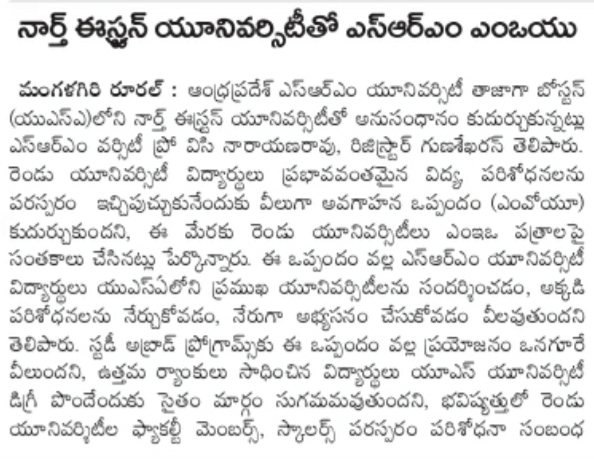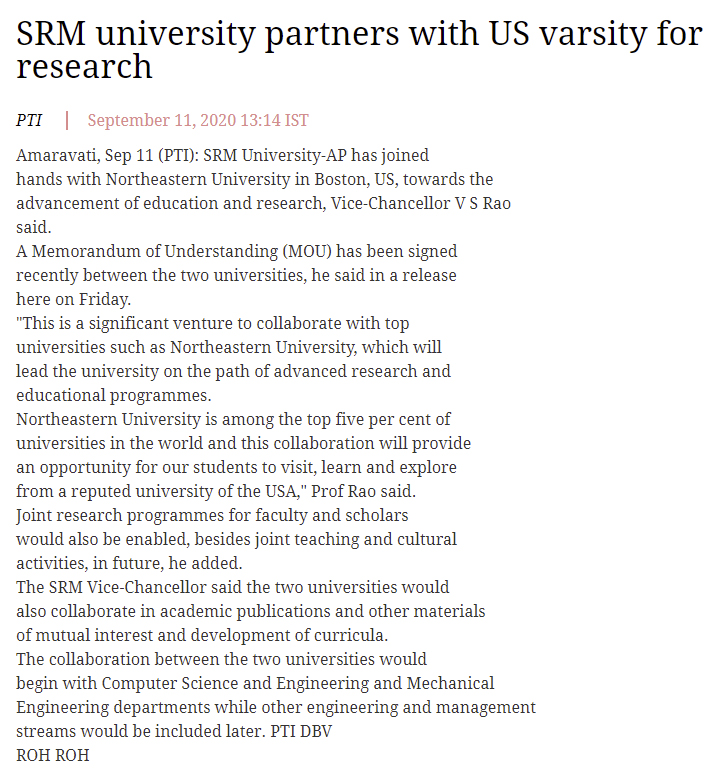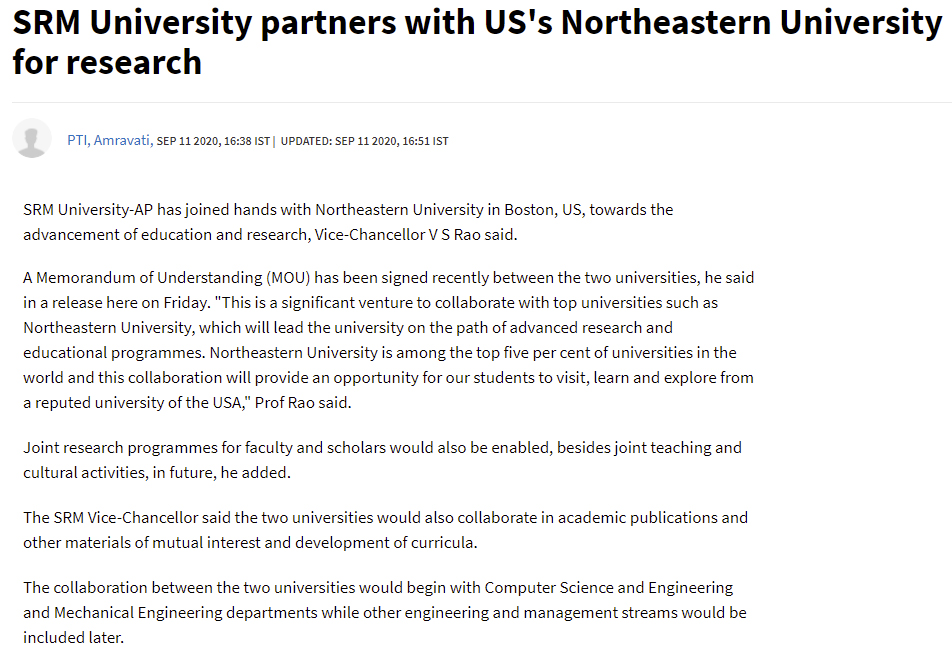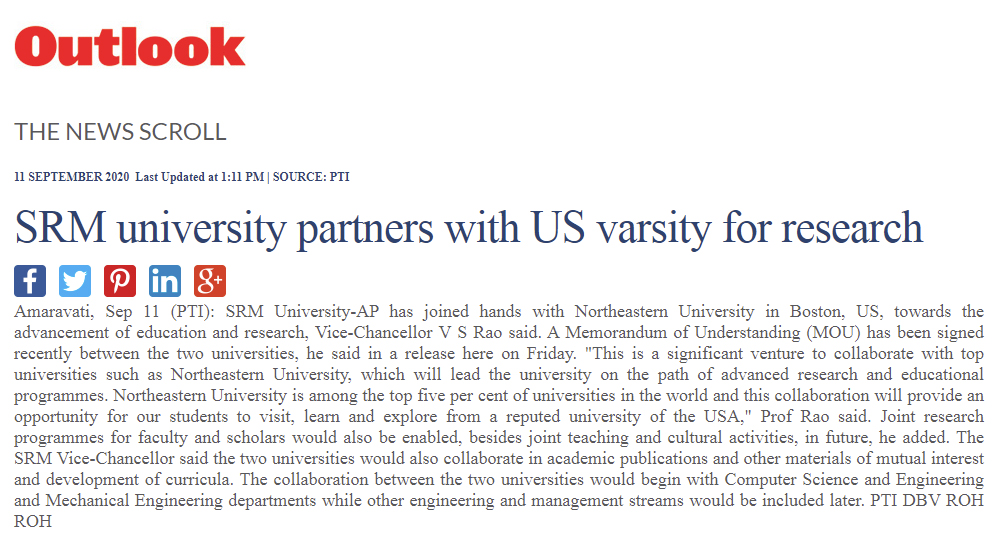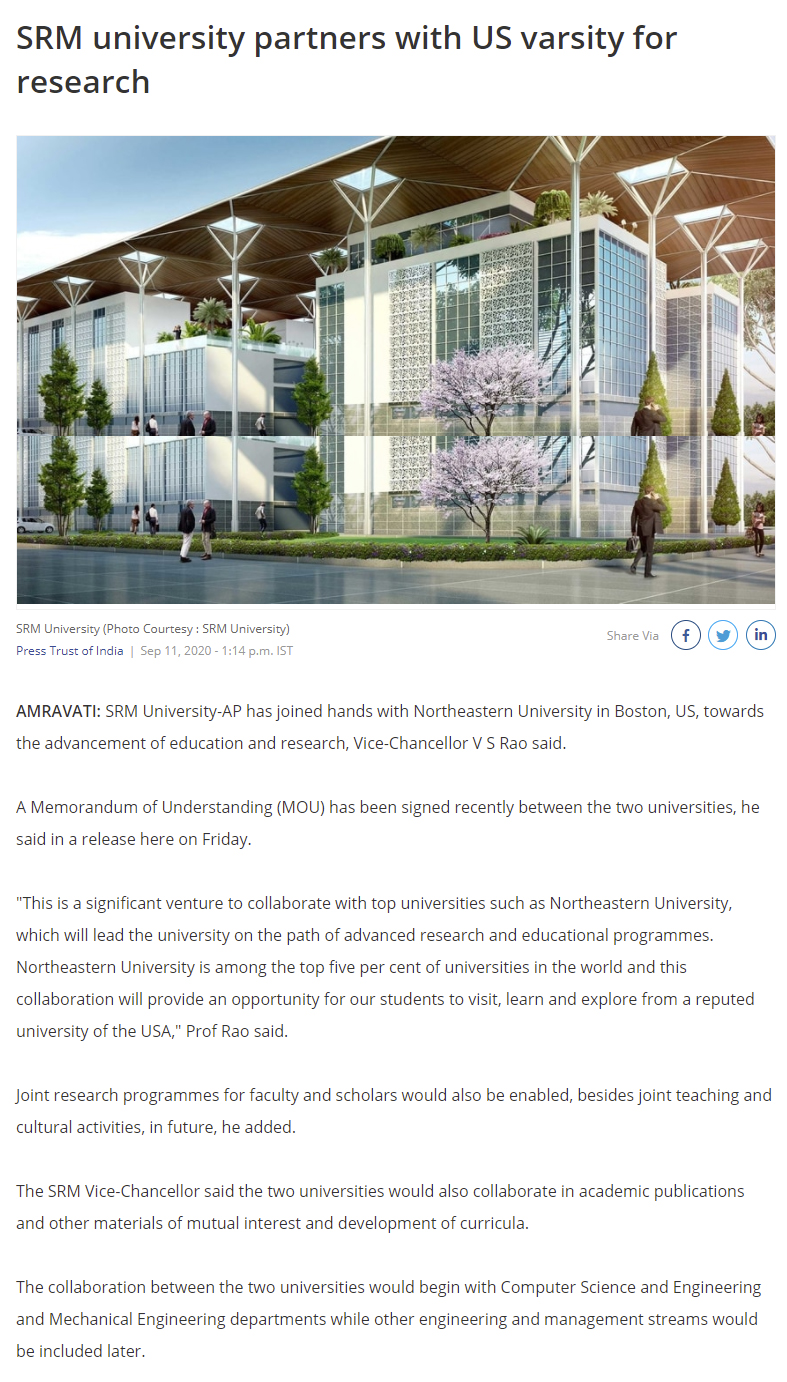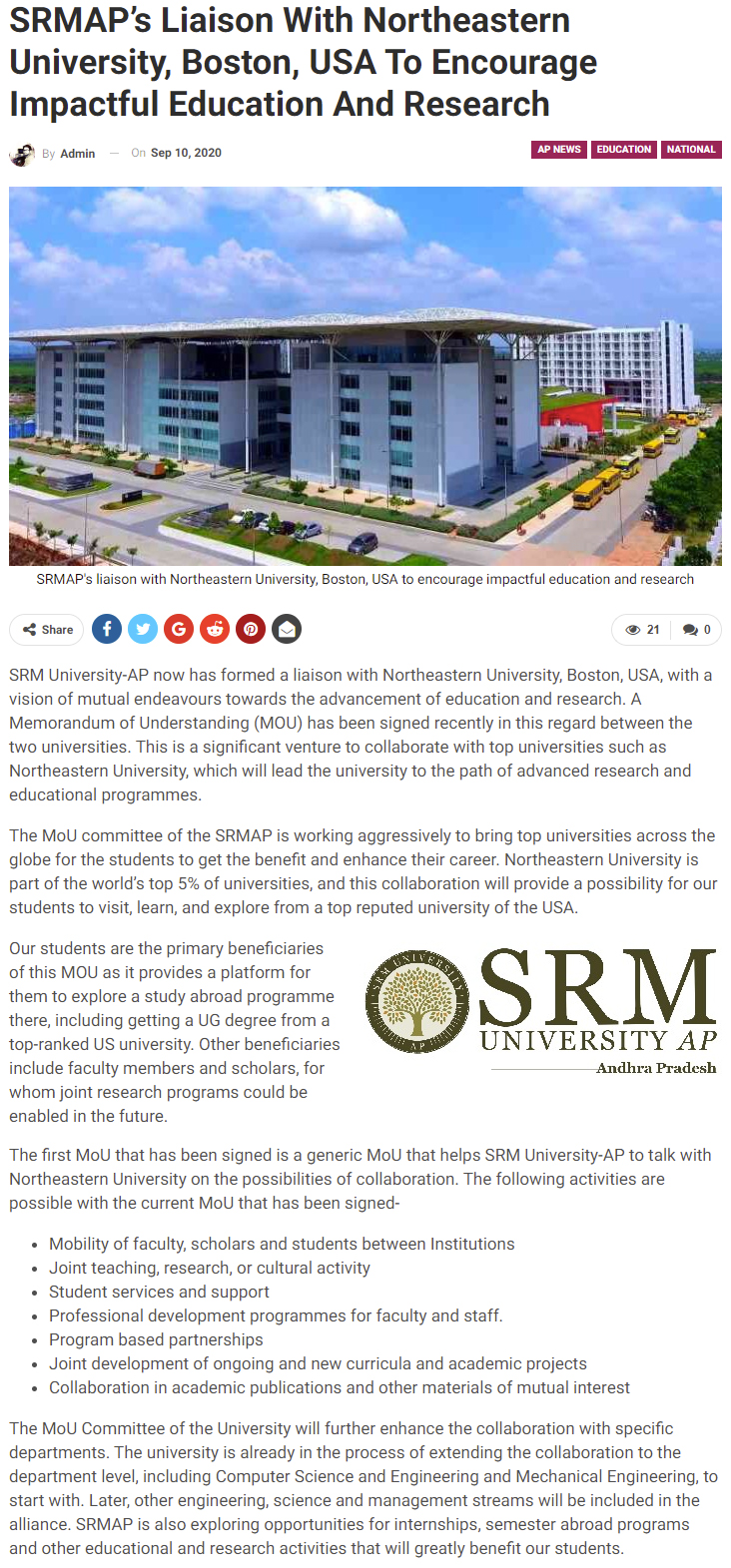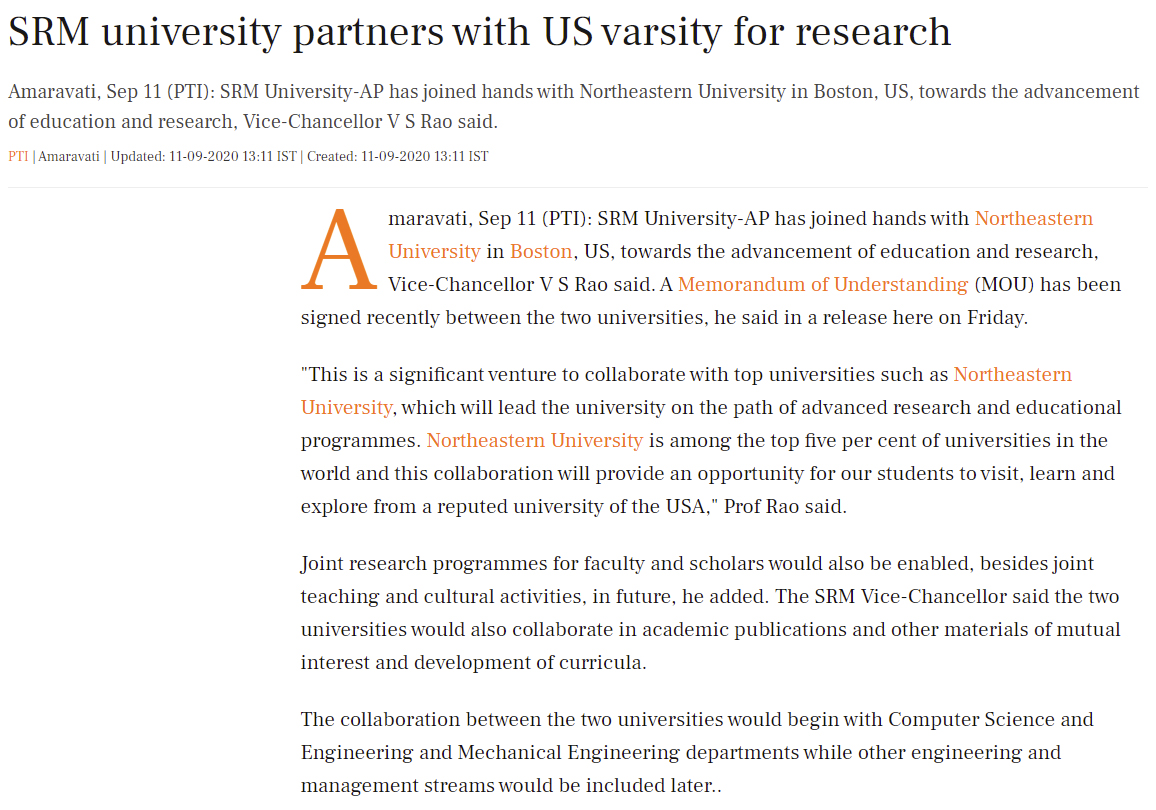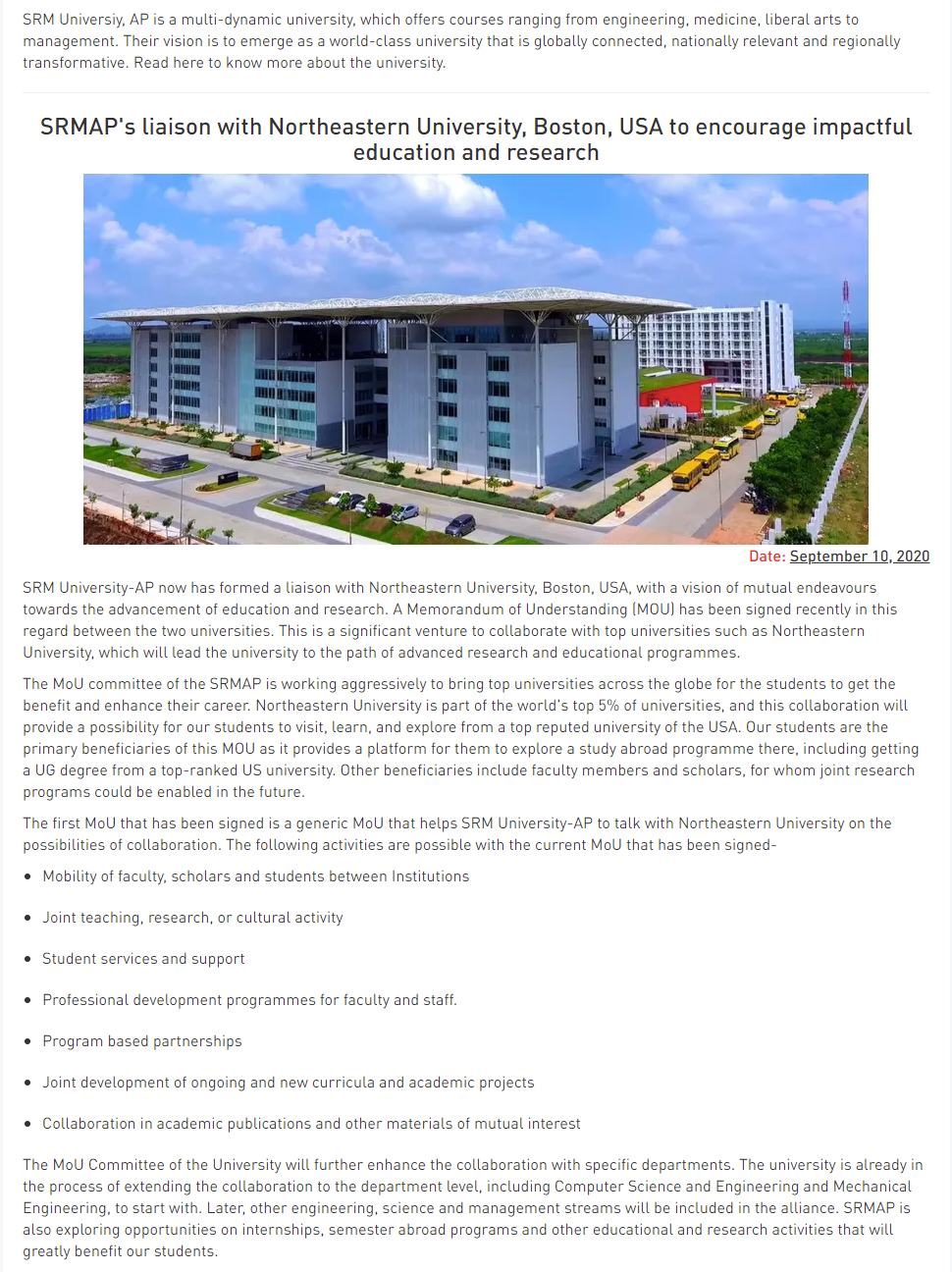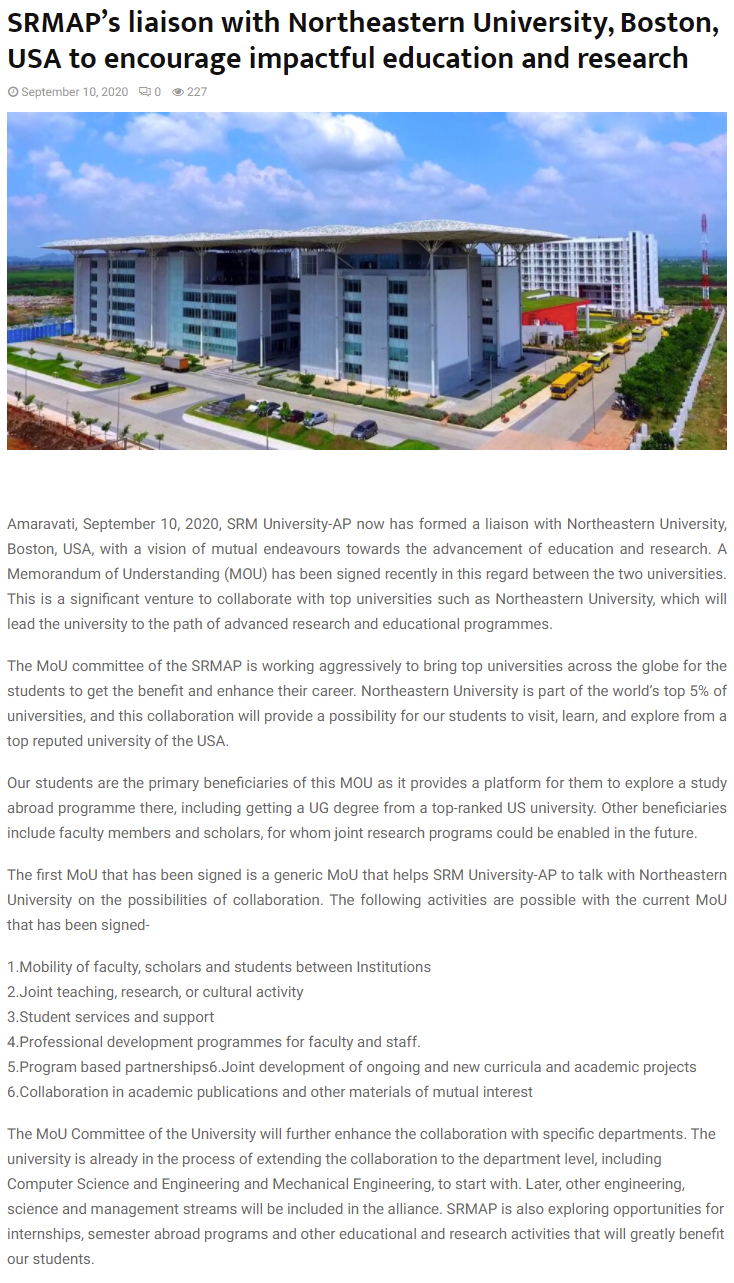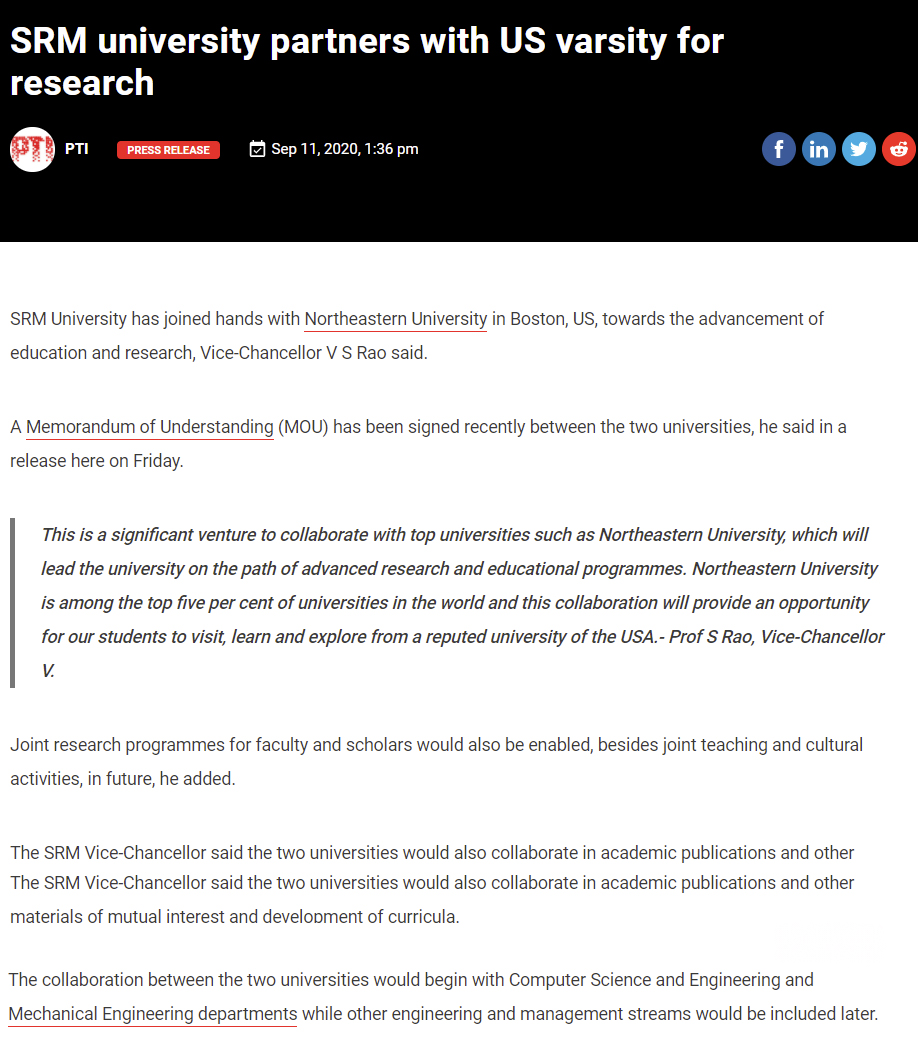All Management News
- Erra Kamal Sai Sadharma September 15, 2020
- Orientation Programme 2020 September 15, 2020
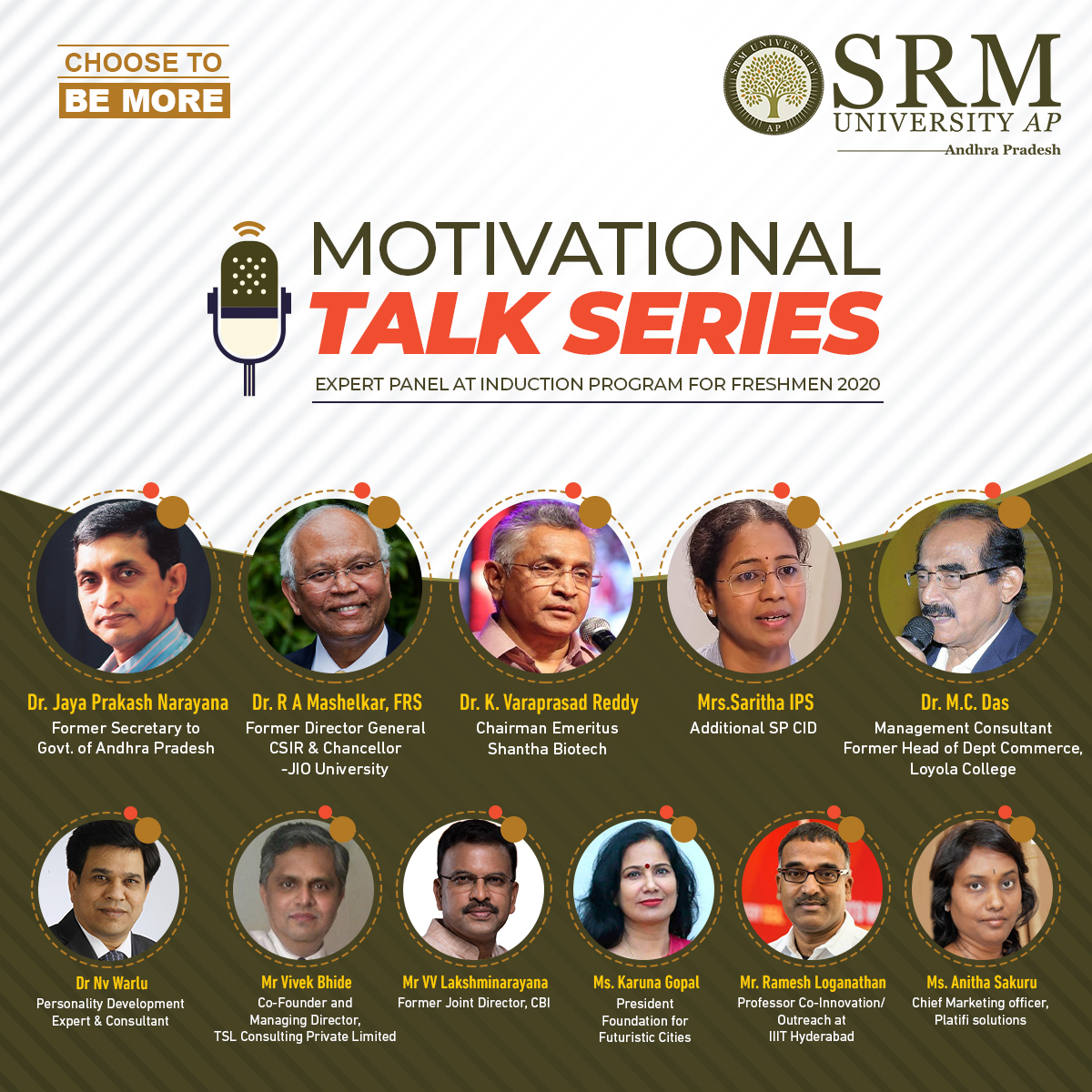 SRM University-AP, Andhra Pradesh affectionately welcomes the Freshmen 2020 to embark on the erudite journey that would transform their lives, and steer them towards becoming a global professional. The university is organizing an online Orientation Programme from September 16, 2020 till September 29, 2020 to provide insights concerning the life at SRM AP.
SRM University-AP, Andhra Pradesh affectionately welcomes the Freshmen 2020 to embark on the erudite journey that would transform their lives, and steer them towards becoming a global professional. The university is organizing an online Orientation Programme from September 16, 2020 till September 29, 2020 to provide insights concerning the life at SRM AP.At the onset, the dynamic leaders of SRM AP will be addressing the Freshmen on September 16, 2020, at 2 p.m. Dr P Sathyanarayanan, Founder, President & Chairman will be delivering the inaugural address. Further, Prof V S Rao, Vice-Chancellor, will be presenting the welcome speech where he will be introducing the various elements of the university. Finally, Prof D Narayana Rao, Pro Vice-Chancellor, will be presenting the vote of thanks.
Eminent personalities have been requested to initiate motivational discussions during the Orientation Programme. Dr. Jaya Prakash Narayana, Former Secretary to Govt. of Andhra Pradesh, will be speaking on September 17, 2020 at 2.30 p.m., followed by a session at 4 p.m. by Dr R A Mashelkar, FRS, Former Director General CSIR & Chancellor-JIO University. On the next day, Padma Bhushan Dr. K. Varaprasad Reddy, Chairman Emeritus-Shantha Biotech will be delivering a speech at 11 a.m. The students will get to hear from Mrs Saritha, IPS, Additional SP-CID, on September 19, 2020 at 11 a.m. Progressing with the programme, SRM AP requests Dr Nv Warlu, a certified Neurolinguistic Programming trainer, personality development coach, writer, motivator, and educator, to inspire the Freshmen on September 21, 2020 at 10.45 a.m. Also, Dr MC Das, Management Consultant-Vijayawada, and Head of the Dept. of Commerce (Retd.)-Loyola College, will be presenting a lecture on September 22, 2020 at 11 a.m.
Beyond the motivational lectures, SRM AP has requested Mr Ramakrishna Mallela, and Mrs G Sailaja, to organize a three-day session on Heartfulness titled “GOAL (Go On And Lead)”. Mr Ramakrishna, who will be addressing the participants during the Orientation Programme on September 22-23, 2020, is a professional faculty, trainer, coach, and mentor having experience in HR Management spanning across 20 years. Further, Mrs G Sailaja is renowned for imparting training in Heartfulness tools and initiatives for the last 5 years. She will be conducting the session with the young students of SRM AP on September 24, 2020.
Moving ahead, Mr Vivek Bhide, Entrepreneur, Co-Founder, and Managing Director-TSL Consulting Pvt Ltd, will be encouraging the young students of SRM AP on September 23, 2020 at 11 a.m. by speaking on “How to develop a start-up culture”. Further, VV Lakshminarayana, Former Joint Director- CBI, will be taking the dais on September 24, 2020 at 11 a.m. while, Ms Karuna Gopal, President-Foundation for futuristic cities has been invited to speak on September 25, 2020 at 11 a.m. where she will be emphasizing on “Role of Students in Building New India”.
Mr Ramesh Loganathan, Professor Co-Innovation/Outreach at IIIT Hyderabad, will be addressing the students on September 26, 2020 at 11 a.m. Also, Ms. Anitha Sakuru, Chief Marketing officer-Platifi Solutions, will be delivering an entrepreneurial talk on September 28, 2020 at 11 a.m. In addition, the deans, departmental heads, and faculty members of SRM AP will introduce the departments, labs, clubs, facilities, online classes, and centres of the university during various sessions sprawled across the 2 week orientation programme. Along with it, the freshmen will get the opportunity to interact with Prof V S Rao followed by the senior students who would advise and motivate the students to ease their predicaments.
Continue reading → - Novel cost-effective framework for autonomous vehicle infrastructure September 15, 2020
Simulating time-variant channel impulse response for mmWave I2I channels using Doppler spread information
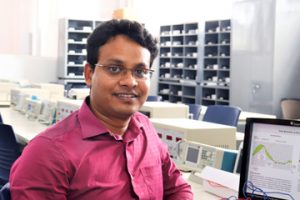 Dr Anirban Ghosh
Dr Anirban GhoshDr Anirban Ghosh, Assistant Professor, Electronics and Communication Engineering, has recently published a paper titled “Time Variance of 60 GHz VI2I channel”. The paper is published in the renowned journal Elsevier-Vehicular Communication with an Impact Factor of 4.7. This paper explores the implementation challenges in unlicensed 60 GHz frequency band for autonomous vehicle infrastructure. This work has been implemented in collaboration with his colleagues from NIT Durgapur and collaborators from Brno University under the aegis of Prof. Ales Prokes. This work is also funded by the Science Foundation grant (Czech) and National Sustainability Program grant (Czech) and DST-Core Research Grant(India).
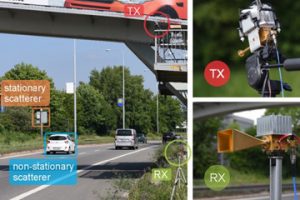 Fig 1: Field test setup at the measurement site
Fig 1: Field test setup at the measurement siteSmart cities are cities on the move; having a mission of delivering people and goods with zero congestion, zero fatality and zero energy wastage. For realising this mission, a smart city needs an intelligent transport system (ITS). As far as the communication aspect of ITS is concerned, historically, the urban ITS planners were more concerned about vehicle-to-vehicle (V2V) and vehicle-to-infrastructure (V2I) modes of communication. This is because the V2V and V2I channels are essentially wireless, and establishing reliable low-latency links over these channels is challenging. Infrastructure-to-infrastructure (I2I) communication is also an integral part of the ITS initiative, and due to their rapid, dynamic and non-invasive nature of the installation, wireless I2I links are preferred over wired links in several smart-road based ITS applications. In order to implement wireless I2I communication, transceivers may be fitted with different kinds of roadside units (RSUs), e.g., short height traffic signposts, overhead gantries, and cantilever sign supports. The traditional role of these RSUs is to support the basic ITS goals, i.e. driver assistance or traffic management. As the vehicular networks scale-up, ITS computations are being shifted to the edge, and the RSUs are going to play more prominent roles in the form of edge computing devices. For example, RSUs can form the cloudlet layer of a vehicular fog computing (VFC) architecture for the internet of vehicles (IoV).
Vehicular wireless I2I channels realise fixed-to-fixed (F2F) radio communication between two RSUs. For any F2F radio channel with stationary transmitter (TX) and receiver (RX), the time-variance is caused by the mobility of the scatterers. These mobile scatterers, say passersby for an indoor scenario, or passing vehicles for an outdoor scenario, cause changes in path lengths in a fading multipath channel. When viewed in frequency-domain, this yields a change in carrier frequency termed as Doppler shift which is proportional to the velocity of the scatterer, and the spectral broadening caused by the time rate of change of the channel is measured with the Doppler spread. Information about Doppler spread is critical for V2V applications such as platooning. In the context of V2I applications, accurate estimation of the Doppler spread is required for designing adaptive transceivers, smart antennas and for determining cellular handoffs. Doppler spread information can also be used for I2I applications like speed estimation. The radar-based solution has a lower latency compared to a camera-based solution, owing to the video acquisition and processing time of the later. As the Doppler shift is a linear function of the carrier frequency, it is of greater concern while moving up in the frequency ladder to the millimetre wave (mmWave) regime. The Doppler spread in the unlicensed 60 GHz mmWave band would be 10-30 times that in the current sub-6 GHz band, with a range spanning from 10 Hz to 20 kHz depending on the velocity of the scatterers. Moreover, compared to V2V links, the effect of moving scatterers is much more pronounced in F2F links; walking pedestrians with a velocity order of ∼ 1 m/s or even the tree leaves fluttering in the wind are important for F2F channel modelling. For highways, the moving vehicles have a velocity an order higher (> 10 m/s) and contribute significantly to the time-variance of the roadside wireless I2I links.
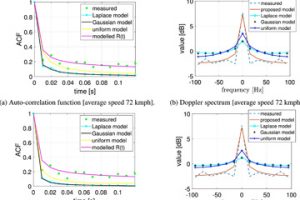 Fig 2: Comparison of the measured and
Fig 2: Comparison of the measured and
proposed models of ACF and Doppler
Spectrum with existing analytical modelsIn this paper, Dr Ghosh studied the time-variance of a roadside infrastructure to infrastructure (I2I) channel operating at 60 GHz millimetre wave (mmWave) band, where the time-variance is caused by moving vehicles acting as scatterers. At first, measurement data is obtained by placing the transmitter (TX) and the receiver (RX) at different heights to emulate a link between two nonidentical roadside units (RSUs), and time-domain channel sounding is performed by sending complementary Golay sequences from the TX to the RX. A linear piecewise interpolation of the corresponding temporal auto-correlation function (ACF) is used to find the Doppler spread of the I2I channel, where their interpolation method compensates for a slower sampling rate. Next, a framework is presented for the time-variant channel impulse response (CIR) simulation, which focuses on moving scatterers only and validates the linear piecewise ACF model. The framework is useful for time-variant vehicular I2I channel simulation and in speed estimation related vehicular applications. Finally, a double-slope curve-fitted analytical model for ACF is proposed as a generalisation to the linear piecewise model. The proposed model and its Doppler spectrum are found to be in agreement with the analytical results for fixed-to-fixed (F2F) channels with moving scatterers and matches perfectly with the measured data. “Our research has explained a framework for simulating time-variant channel impulse response (CIR) for mmWave I2I channels with moving scatterers using Doppler spread information – which provides means to study the various characteristics of an I2I channel even without carrying out any expensive channel sounding campaign”, said Dr Ghosh.
Dr Ghosh and his collaborators are currently exploring further challenges in communication between vehicles (V2V) in the same frequency range (60 GHz).
To know more about the paper, please visit- https://www.sciencedirect.com/science/article/abs/pii/S2214209620300590?dgcid=coauthor
Continue reading → - SRMAP’s collaborative research on Inertial Electrostatic Confinement with BARC. September 15, 2020
Dr Somesh Tiwari has received Mentoring of Engineering Teachers by INAE (Indian National Academy of Engineering) Fellowship -2020.
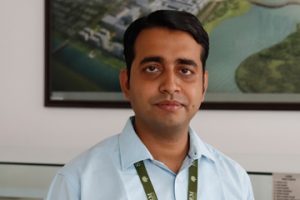
Dr Somesh Vinayak Tewari, Assistant Professor, Department of Electronics and Electrical Engineering, brings another honour for SRM University-AP. He has been selected for Mentoring of Engineering Teachers by INAE (Indian National Academy of Engineering) Fellowship -2020. His mentor during the programme will be Dr Archana Sharma, FIE, FNAE, Outstanding Scientist, Bhabha Atomic Research Centre.
The INAE (Indian National Academy of Engineering) provides funding to an Engineering Teacher for carrying out research in the selected/proposed area to be mentored by an INAE fellow. The scheme attempts to increase the knowledge base and is instrumental in building long term collaborations. Such mentoring program helps in bridging the collaboration between an academic area and a research and development organization which is extremely necessary to sow the seeds of research in young and energetic brains so that they are able to translate their research ideas for further growth. This interaction of ideas leads to a win-win situation for both the University and the research organization. The prestigious and highly competitive fellowship receives thousands of applications nationwide though only fifteen of them finally are selected for the fellowship this year by INAE. Dr Somesh is one of fifteen outstanding researchers.
Dr Tiwari will be working on the proposed research topic- “Studies on Inertial Electrostatic Confinement Concept in Deuterium gas environment”. Inertial Electrostatic Confinement (IEC) is an alternative concept to Magnetic and Inertial fusion. IEC fusion device is an extremely compact and simple device, running by high voltage as discharge on Deuterium -Deuterium/Deuterium-Tritium/Deuterium -3He fuel gases. Studies related to IEC find application in the areas of dosimeter calibration, isotope production, radiography, and has medical applications. Such a research is multifaceted and helps an engineering teacher to enhance his skills in experimental areas of high voltage, plasma physics, vacuum techniques, radiation detection and measurement and in numerical methods and simulation leading to a comprehensive analysis of a given problem. During the two months of the fellowship, Dr Archana Sharma will be mentoring the project. It is an excellent opportunity for our faculty to work with such a renowned scientist in such close proximity. The collaboration will be beneficial for both institutions.
Continue reading → - Dr. Goutam Rana September 14, 2020
- The Industry Readiness Webinar Series September 14, 2020
The Industry Readiness Webinar Series provides a forum for the industry experts to share their experience with the students. Through the video workshop, lecture or presentation hosted online; the Speaker uses the platform to share beneficial knowledge, ideas and updates with the stakeholders.
The purpose of the webinar series is to engage an industry expert to host a weekly seminar on a broad spectrum, about the expectations and the pedagogy required to bridge the gap between the academia and the industry on various aspects.
The webinar series includes a wider reach and ability to share knowledge and inherent opportunities to reach out many industrial experts, thereby getting the knowledge imparted from the industry and accessing the general requirement of the industry, which may be very much useful at the time of their campus recruitment.
 The Industry Readiness Webinar Series-1
The Industry Readiness Webinar Series-1 The Industry Readiness Webinar Series-2
The Industry Readiness Webinar Series-2 The Industry Readiness Webinar Series-3
The Industry Readiness Webinar Series-3 The Industry Readiness Webinar Series-4
The Industry Readiness Webinar Series-4 The Industry Readiness Webinar Series-5
The Industry Readiness Webinar Series-5 The Industry Readiness Webinar Series-6
The Industry Readiness Webinar Series-6 The Industry Readiness Webinar Series-7
The Industry Readiness Webinar Series-7The Industry Readiness Webinar Series-8
Topic: “Do’s and Don’ts of the online interview”
Resource Person: Mr.Rahul Sivakumar, Lennox India Technology Centre
Date: 31/05/2020
Time: 12.00 pm to 01.00 pmThe Industry Readiness Webinar Series-9
Topic: Virtual Interview preparation
Resource Person: Mr.Shivaraj G., Media.net, Mumbai
Date: 29/05/2020
Time: 10.30 am to 12.00 pm The Industry Readiness Webinar Series-10
The Industry Readiness Webinar Series-10
Continue reading → The Industry Readiness Webinar Series-11
The Industry Readiness Webinar Series-11 - Teacher’s Day Programme at SRM AP September 12, 2020
The Hindu Education Plus – September 11
Continue reading →
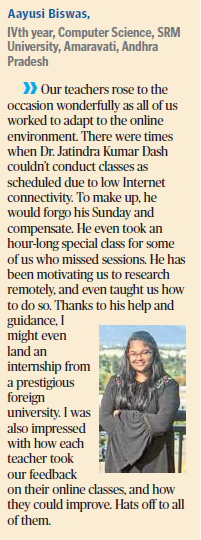
- Top performers to interact during the session: “Newsmakers” September 12, 2020
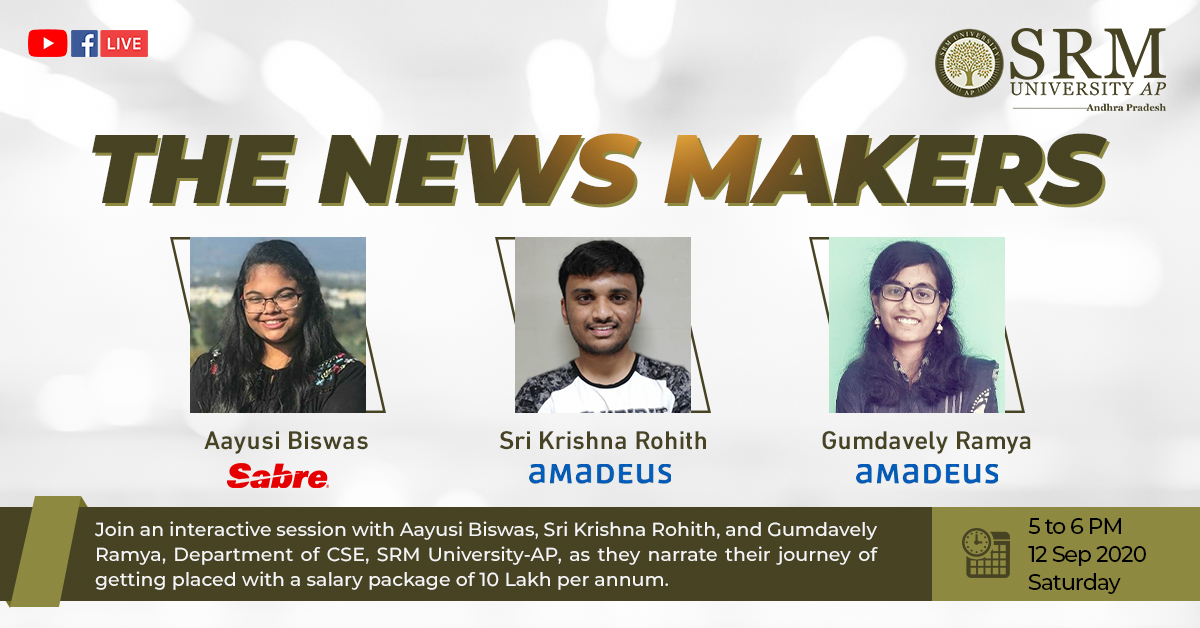 Department of Student Affairs, SRM University-AP, Andhra Pradesh, invites Aayushi Biswas, Sri Krishna Rohith, and Gumdavely Ramya to interact with the audience during the webinar “Newsmakers”. The students prepared incessantly to excel in the recruitment drive and received enviable job offers from Sabre Corporation, and Amadeus Labs, respectively. The insightful narrative of their journey of achieving their dreams, and the efforts put in for the same, will be discussed during the session. Tune in on September 12, 2020 at 5 p.m. to comprehend how the opportunities offered by SRM AP enabled them to accomplish their career goals.
Department of Student Affairs, SRM University-AP, Andhra Pradesh, invites Aayushi Biswas, Sri Krishna Rohith, and Gumdavely Ramya to interact with the audience during the webinar “Newsmakers”. The students prepared incessantly to excel in the recruitment drive and received enviable job offers from Sabre Corporation, and Amadeus Labs, respectively. The insightful narrative of their journey of achieving their dreams, and the efforts put in for the same, will be discussed during the session. Tune in on September 12, 2020 at 5 p.m. to comprehend how the opportunities offered by SRM AP enabled them to accomplish their career goals. Registration Link: Please Click Here
Continue reading → - Northeastern University and SRMAP signed MOU September 11, 2020
SRMAP’s liaison with Northeastern University to encourage impactful education and research
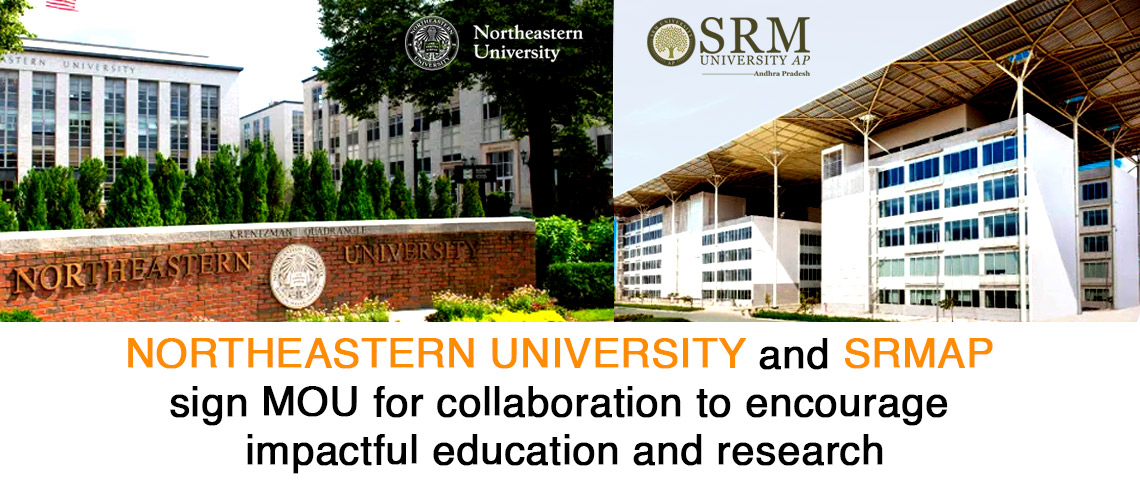
SRM University-AP now has formed a liaison with Northeastern University, Boston, USA, with a vision of mutual endeavours towards the advancement of education and research. A Memorandum of Understanding (MOU) has been signed recently in this regard between the two universities. This is a significant venture to collaborate with top universities such as Northeastern University, which will lead the university to the path of advanced research and educational programmes.
The MoU committee of the SRMAP is working aggressively to bring top universities across the globe for the students to get the benefit and enhance their career. Northeastern University is part of the world’s top 5% of universities, and this collaboration will provide a possibility for our students to visit, learn, and explore from a top reputed university of the USA.
Our students are the primary beneficiaries of this MOU as it provides a platform for them to explore a study abroad programme there, including getting a UG degree from a top-ranked US university. Other beneficiaries include faculty members and scholars, for whom joint research programs could be enabled in the future.
The first MoU that has been signed is a generic MoU that helps SRM University-AP to talk with Northeastern University on the possibilities of collaboration. The following activities are possible with the current MoU that has been signed-
• Mobility of faculty, scholars and students between Institutions
• Joint teaching, research, or cultural activity
• Student services and support
• Professional development programmes for faculty and staff.
• Program based partnerships
• Joint development of ongoing and new curricula and academic projects
• Collaboration in academic publications and other materials of mutual interestThe MoU Committee of the University will further enhance the collaboration with specific departments. The university is already in the process of extending the collaboration to the department level, including Computer Science and Engineering and Mechanical Engineering, to start with. Later, other engineering, science and management streams will be included in the alliance. SRMAP is also exploring opportunities on internships, semester abroad programs and other educational and research activities that will greatly benefit our students.
Continue reading → - SRM AP inks MOU with Northeastern University September 11, 2020
The Hindu – September 11
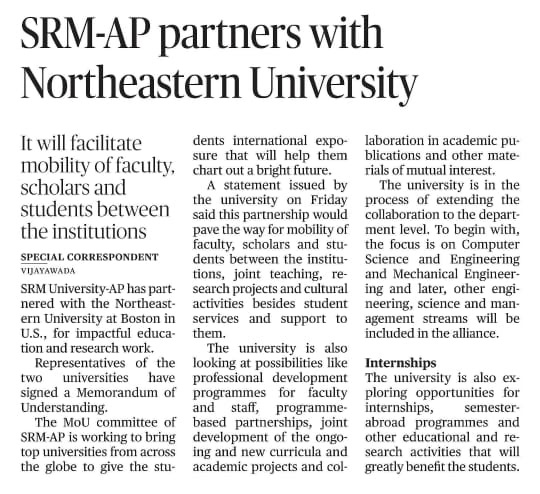
Times of India – September 11
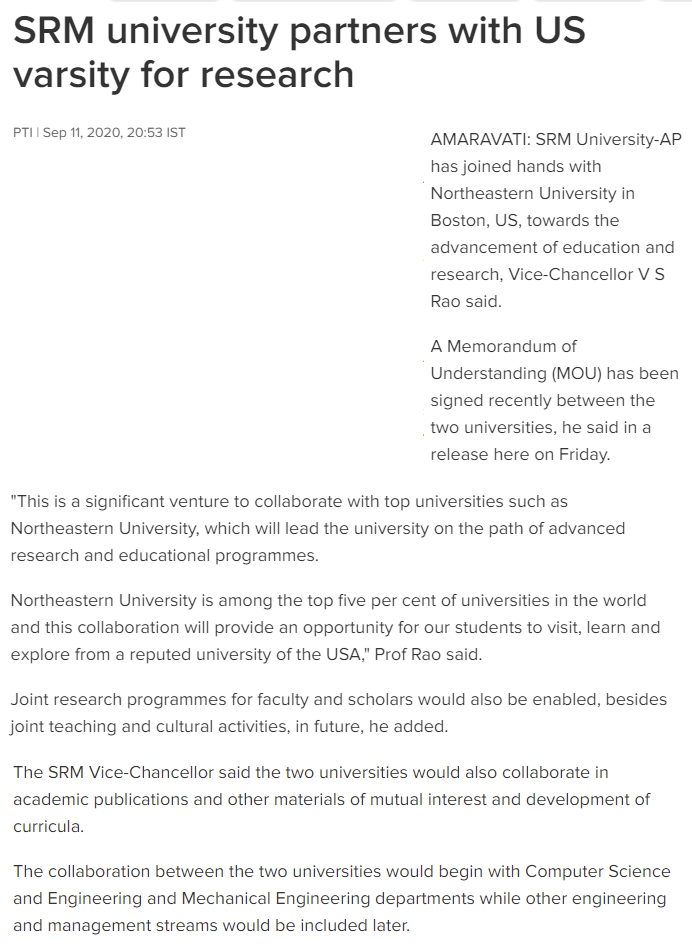
Financial Express – September 11
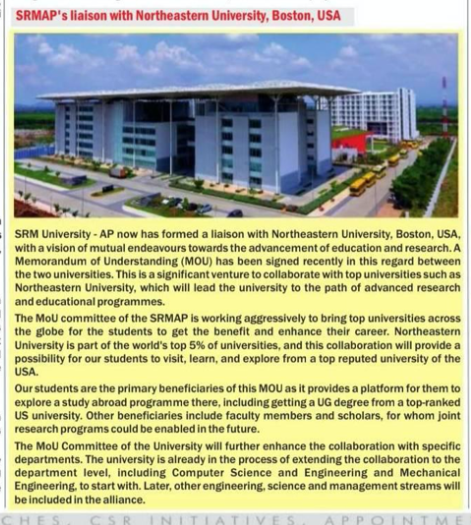
The Hawk – September 11
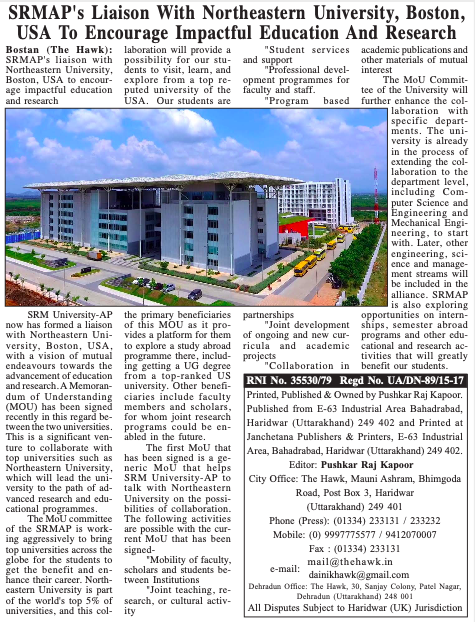
Business News This Week – September 11
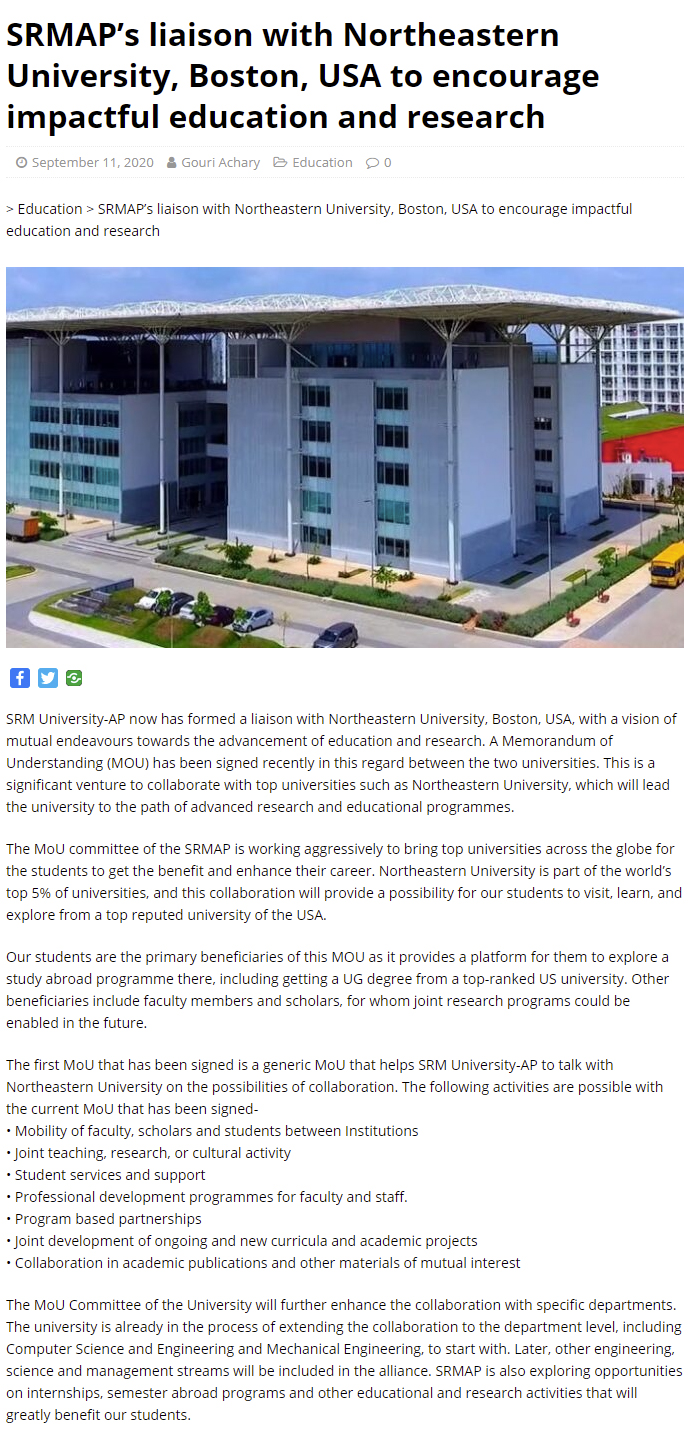
United News of India – September 11
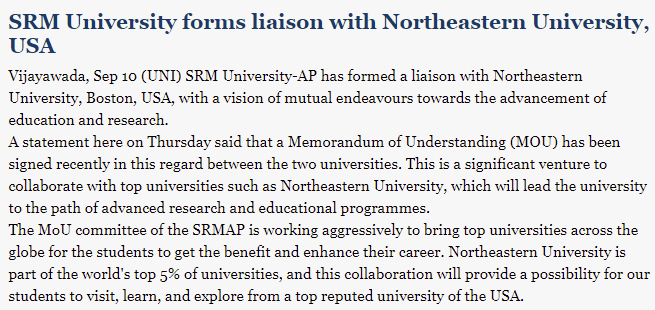
India EducationDiary – September 11
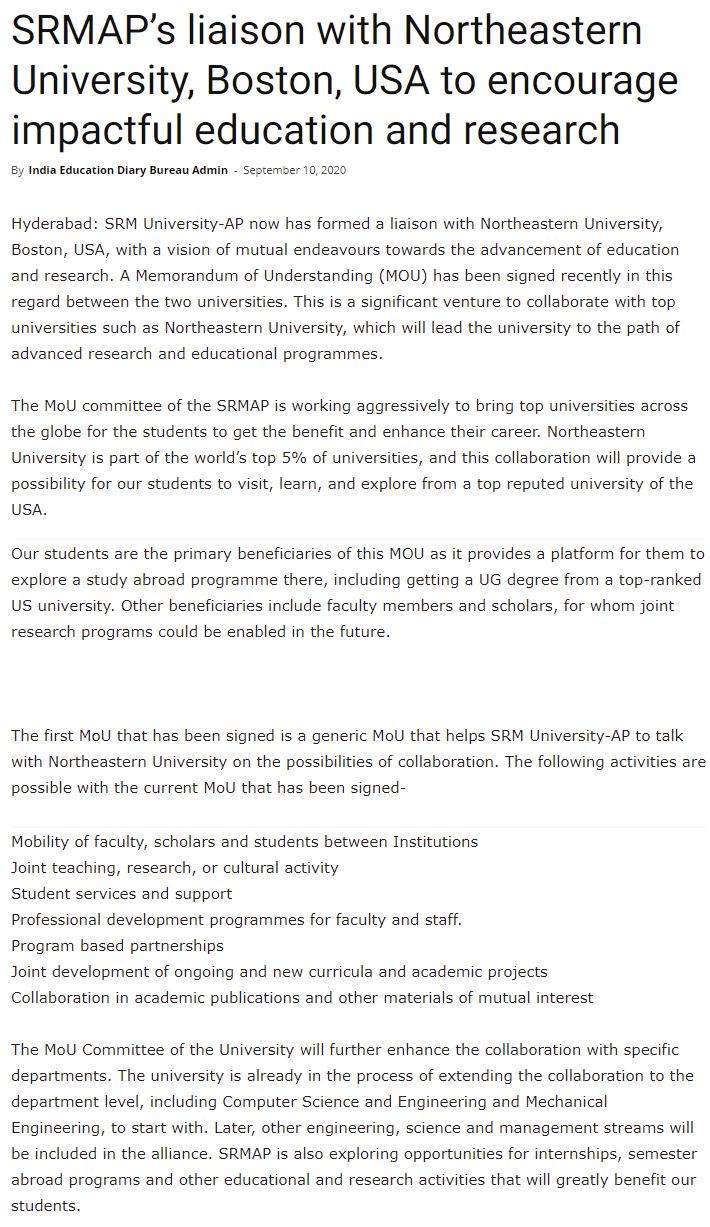
Higher Education Digest – September 11
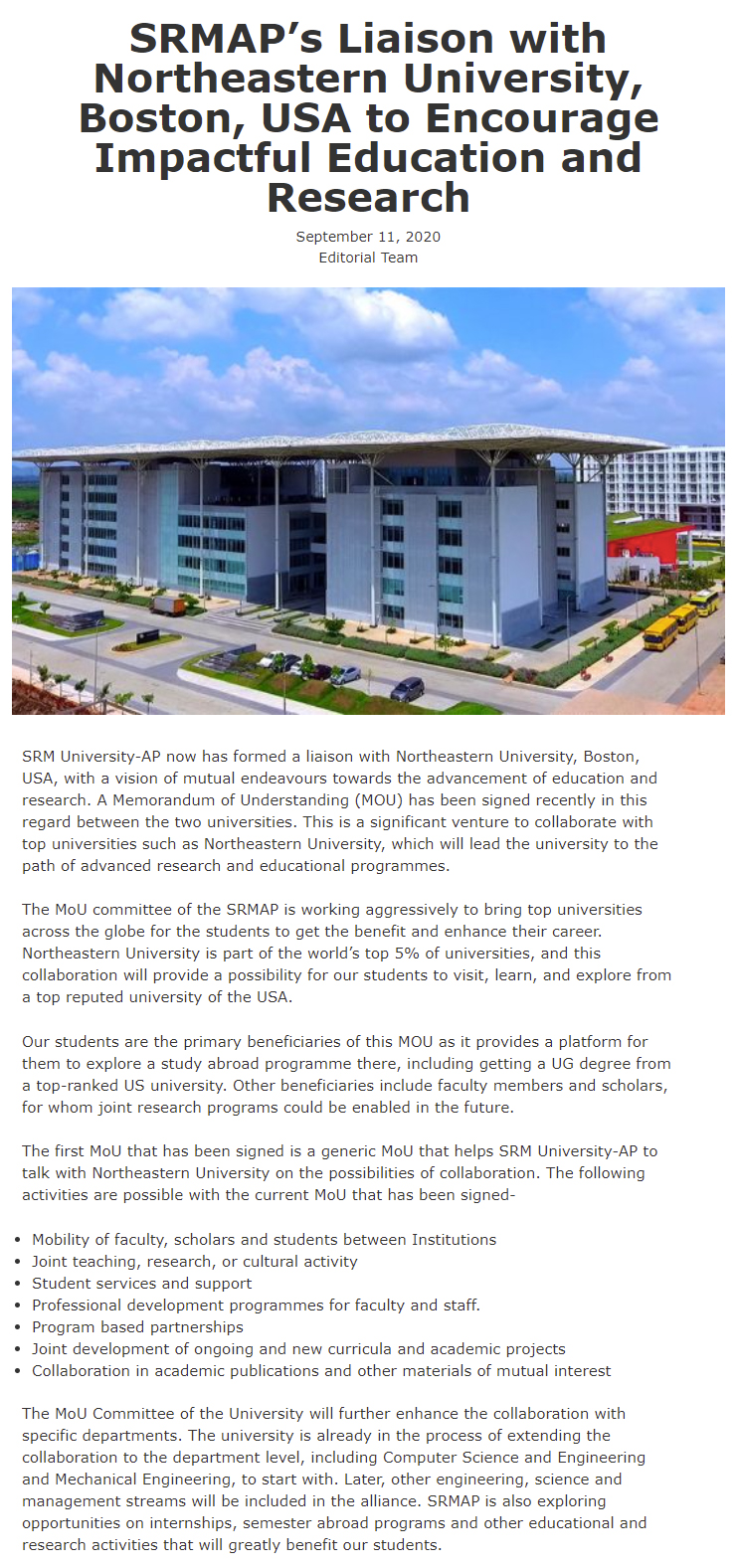
Daily Pioneer – September 11
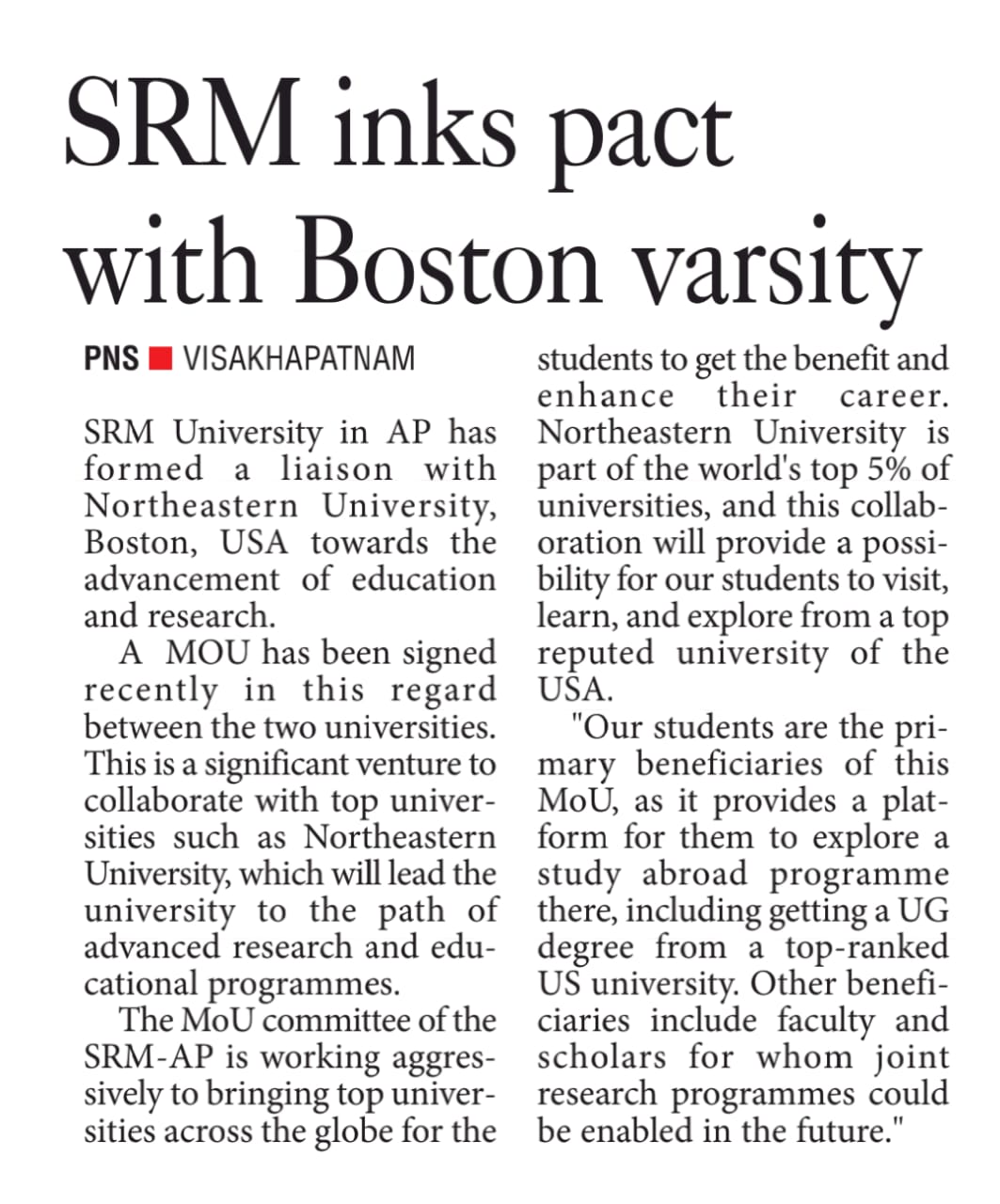
Education Brainiac – September 11
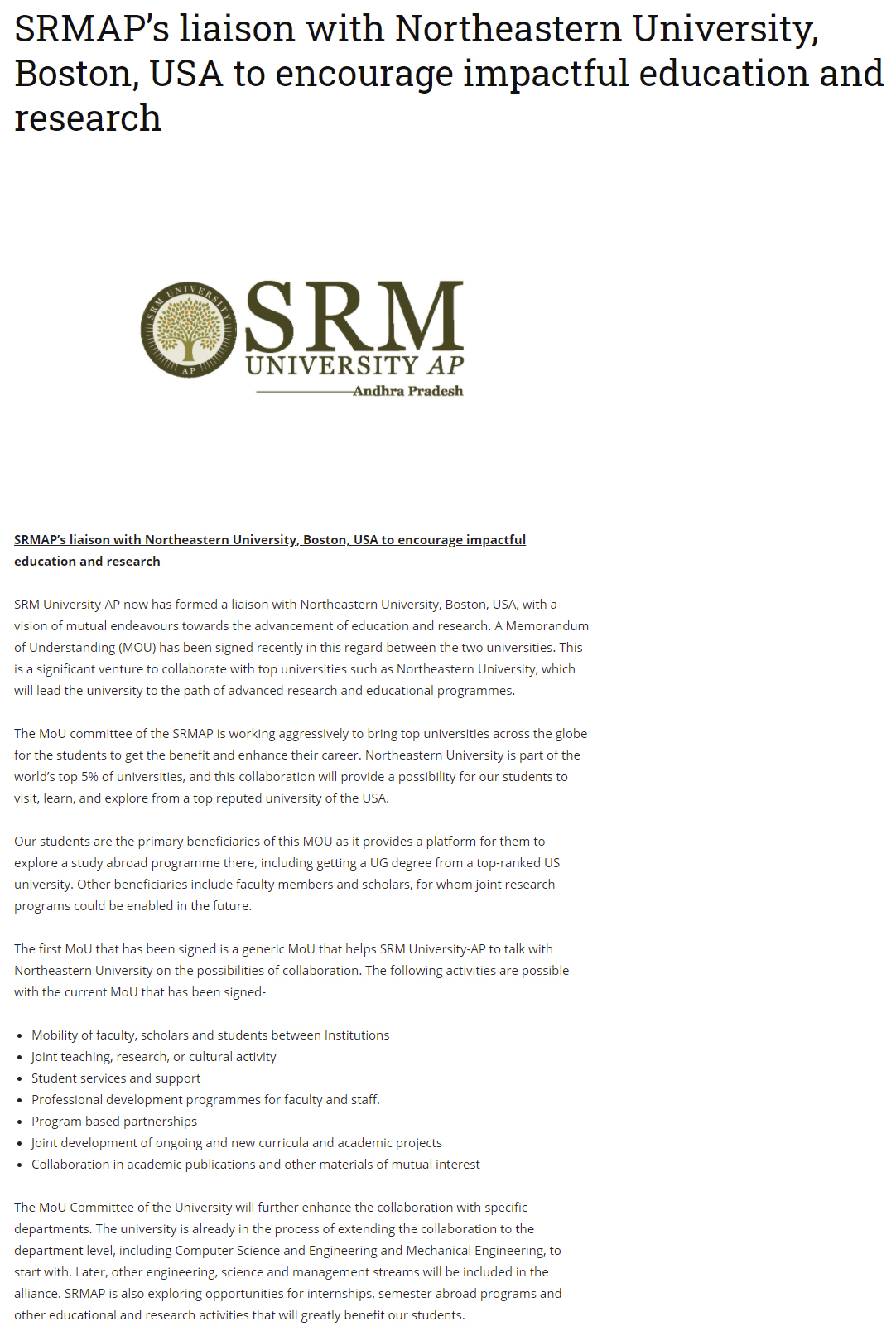
Media Bulletins – September 11
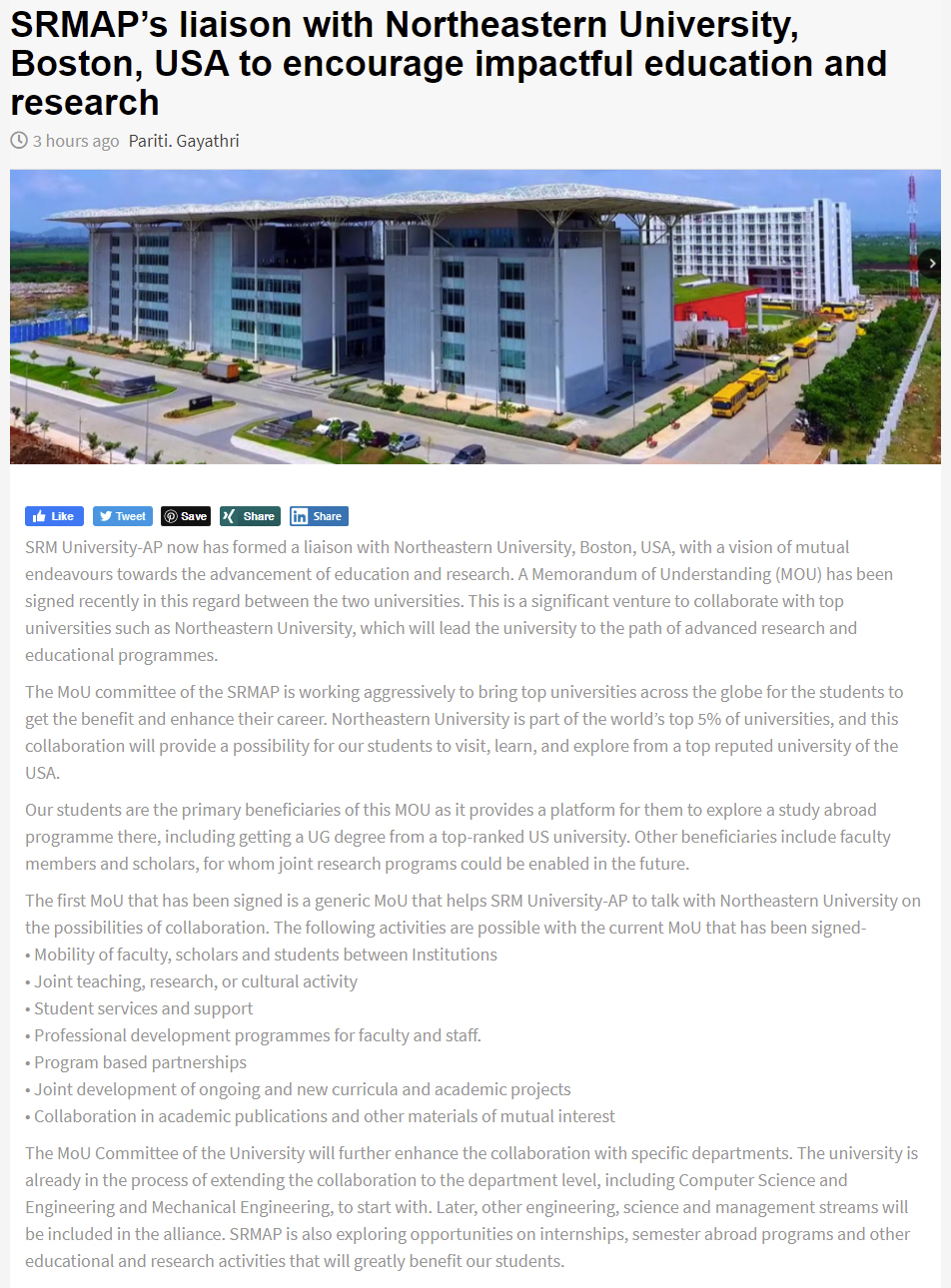
Andhra Prabha – September 11
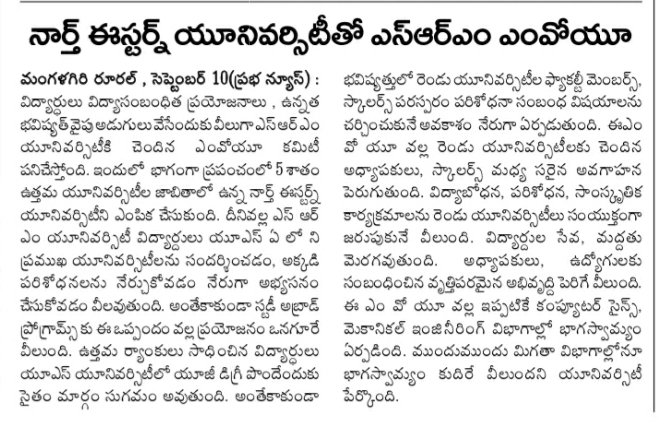
Vartha Prapancham – September 11
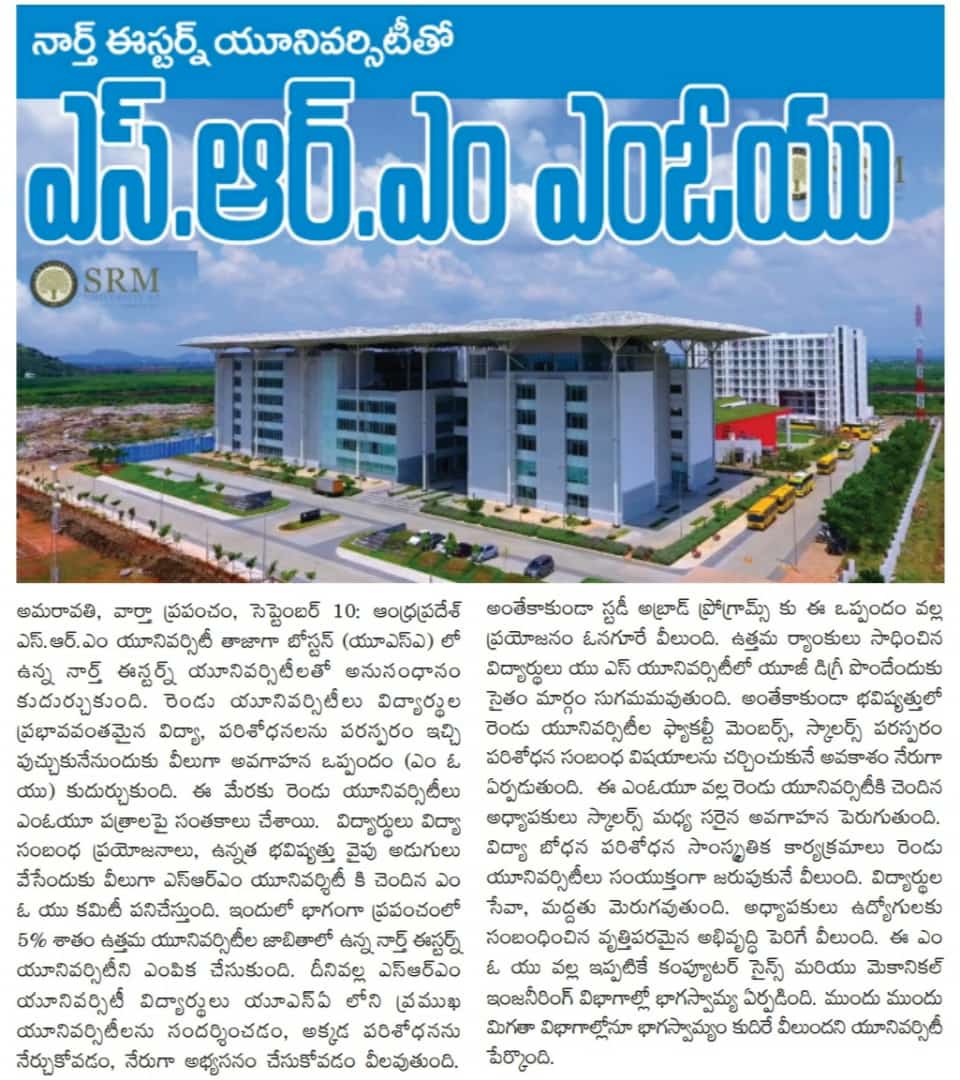
Visallandhara – September 11
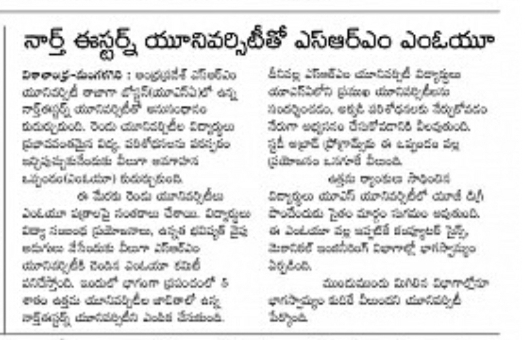
PrajaSakti – September 11
Continue reading →
